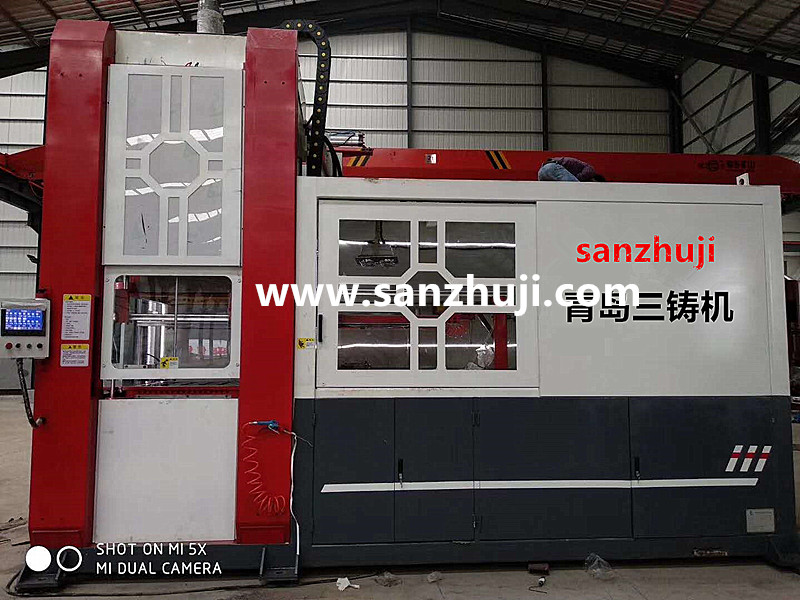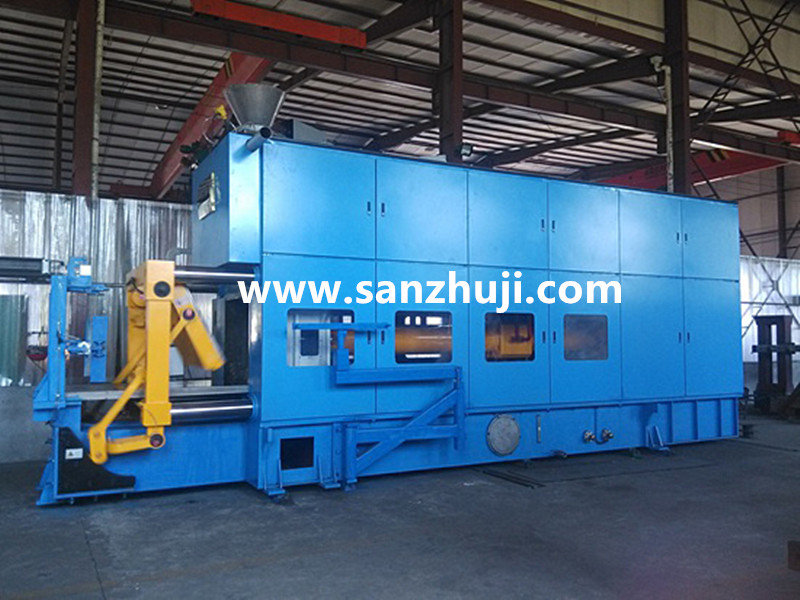1. There is a problem
The flake graphite defects on the surface of the ductile iron produced by the resin no-bake sand process have a thickness of 3-5mm, and there is an extremely thin vermicular graphite transition zone between the flake graphite and the spherical graphite.
2. Reason analysis
The main reason for the appearance of flake graphite in ductile iron is the lack of nodular elements (Mg) when the molten iron solidifies, or the presence of interfering elements such as S. The resin that the foundry that Sanzhuji cooperates with is XY86-A furan resin, and its technical index is as shown in Table 1, and the add-on is 1.0% (accounting for sand); the curing agent is SQ-A and SQ-B, and the add-on is 30~ 50% (accounting for resin). Both SQ-A and SQ-B are sulfonic acid curing agents, and both contain S element, and their technical indicators are shown in Table 2. Through experiments, it is found that the content of S element in the reclaimed sand is relatively high, generally about 0.1%, while the content of S element in the molten iron after spheroidization is relatively low, less than 0.02%. At high temperature, there is a concentration gradient of S element between the solid/liquid interface composed of sand mold and molten iron. S element is transferred from the sand mold to the molten iron. The larger the difference, the stronger the diffusion ability.
At high temperature, S element passes through the coating layer in the form of SO2 gas or in the form of S2- and SO32- ions and enters the molten iron, which increases the content of interfering elements in the surface molten iron. The S element reacts with the Mg element in the molten iron to form Mg oxides and sulfides such as MgO, MgSO3 and MgS, which reduces the residual Mg content on the surface of the casting, resulting in poor spheroidization of the surface of the casting and the appearance of flake graphite structure.
3. Preventive measures
At high temperature, the S element in the molding sand enters the molten iron, which reduces the residual Mg content on the surface of the casting. To prevent abnormal structure on the surface of ductile iron castings, it is necessary to prevent S in the molding sand from entering the molten metal at high temperatures. This problem can be solved from three aspects: one is to reduce the content of S element in the molding sand and reduce the transfer source; the second is to take measures to prevent the transfer of S element from the molding sand to the molten iron, which can be solved from the transfer process; the third is to increase Residual Mg content in molten iron to offset the effect of S. Specifically, there are the following methods:
3.1 Reduce the transmission source
3.11 Reduce the burn reduction of regenerated sand
The sulfur element in the reclaimed sand has a certain proportional relationship with the ignition loss of the reclaimed sand. When the ignition loss is high, the content of S element in the reclaimed sand is also high, and the content of S element in the molding sand will also increase when the amount of sulfonic acid curing agent added and the model remain unchanged. At high temperature, the concentration gradient of S element at the interface between the sand mold and the molten iron increases, and the power of the S element in the molding sand to diffuse into the molten iron also increases, and the amount of S entering the molten iron increases. Defective aggravation. Reducing the ignition loss of the reclaimed sand can not only reduce the sulfur content in the molding sand, but also reduce the gas generation of the molding sand and reduce the probability of pores in the casting.
3.12 Use low sulfuric acid curing agent
The sulfur element in the molding sand mainly comes from the sulfonic acid curing agent. It is difficult to reduce the S element in the molding sand by the general mechanical regeneration method, and controlling the source is the best method. Under the condition of certain regeneration ability, the use of low S curing agent can effectively reduce the sulfur content in the casting mold and the regenerated sand, thereby fundamentally solving the poor spheroidization of the surface layer.
3.13 Reduce the amount of curing agent added
The amount of curing agent added directly affects the hardening speed of molding sand. Under the condition that the initial strength requirements are met, the addition amount of the curing agent should be reduced as much as possible, which can not only reduce the sulfur content in the mold and reclaimed sand, but also reduce the cost. Reducing the amount of curing agent added, the sand hardening speed becomes slower, and the final strength of the mold can be improved to a certain extent. However, the amount of curing agent added should not be too low, otherwise it will be difficult to mix it in a short period of time, resulting in uneven distribution of sand strength and poor surface stability.
3.14 Reduce the ratio of sand to iron and the amount of sand eaten
At the same pouring temperature, the casting mold adopts a lower sand-iron ratio and sand consumption, and the resin curing agent in the molding sand can get more burning loss, and the burning loss and S content of the reclaimed sand will be lower. The use of lower sand-iron ratio and sand consumption can not only reduce the transmission power of S element at the interface between the mold and the molten metal, but also reduce the usage of molding sand, resin and curing agent, as well as the workload of the regeneration system.
3.15 Use a sulfur-free curing agent
Phosphoric acid and other inorganic curing agents do not contain S element, which can fundamentally solve the problem of poor spheroidization on the surface of castings. Phosphoric acid has poor collapsibility at high temperature, and phosphate in reclaimed sand is easy to deposit. When used repeatedly, phosphorus eutectic structure will appear on the surface of castings, and the strength of resin sand will also decrease. Generally, it is only used in self-hardening sand for one-time use.
3.16 Add new sand
The new sand does not contain S element. Adding new sand to the reclaimed sand can reduce the content of S element in the molding sand. The use of 100% reclaimed sand should be avoided. However, the amount of new sand added should not be too high, otherwise the amount of resin curing agent added will increase, but the content of S element in the molding sand will be increased.
3.2 Truncated delivery pathway
3.21 Sulfur blocking paint
Sulfur blocking here refers to adding other substances, such as MgO, to the coating. When the sulfur element enters the molten iron through the coating layer containing MgO in the form of SO2, SO2- and SO32-, it can be absorbed by the MgO in the coating layer.
SO2+MgO→MgSO3
SO23- +Mg2+ → MgSO3
S2- +Mg2+ → MgS
3.22 Improve the cooling rate of castings
The slower the cooling rate, the longer the molten iron remains in the liquid state, and the longer the thermal action time on the sand mold increases the thermal decomposition amount of the curing agent, and at the same time increases the diffusion time of the sulfur element, and the spheroidization decline is aggravated. Increasing the cooling rate of the casting can effectively reduce the diffusion time of sulfur element and reduce the effect of spheroidization recession. In the case of using chilled iron to increase the cooling rate, the molten iron does not contact the resin sand, but contacts with the chilled iron, which accelerates solidification and forms a hard shell, which also avoids the infiltration of sulfur to a certain extent.
3.23 Reduce pouring temperature
In the case of ensuring that no other defects appear, the pouring temperature should be lowered as much as possible. Lowering the pouring temperature can reduce the contact time between sulfur and liquid metal, reduce the diffusion of sulfur, and weaken the effect of spheroidization.
3.3 Offset the effect of S
Increase the residual Mg content of molten iron
Increase the addition amount of rare earth magnesium nodularizing agent, increase the residual Mg content in the molten iron, and consume the interfering element S that diffuses to the surface of the molten iron. This does not completely eliminate the S element diffused to the surface, so the residual Mg content in the molten iron is increased. Only the surface flake graphite area can be thinned, and it cannot be completely eliminated. The residual Mg content should not be too high, otherwise the castings will have defects such as slag holes, shrinkage porosity, pores, etc. In severe cases, the castings will appear cementite structure, which will deteriorate the mechanical properties of the castings.
3.4 Sanzhuji recommends the following measures in combination with the characteristics of furan resin no-bake sand casting
3.41 Increase the detection and maintenance of the burning reduction and regeneration system, and reduce the burning reduction to less than 2%. At this time, the content of S in the reclaimed sand is about 0.05%, which greatly reduces the diffusion power of the S element at the interface between the molding sand and the molten iron. Combining crushing regeneration and eddy current secondary regeneration can improve the surface cleanliness of furan resin regenerated sand.
3.42 Reduce the pouring temperature, reduce the pouring temperature to below 1350 ℃, reduce the contact time between the S element and the liquid metal, and reduce the diffusion of the sulfur element.
3.43 Increase the residual Mg content, and increase the residual Mg from 0.03 to 0.04% to 0.04 to 0.06%.
Qingdao Sanzhuji Equipment Manufacturing Co., Ltd. specializes in the production of Green Sand Molding Line,Self-hardening sand molding line,foundry machines,Sand molding machine,Sand casting equipment,sand mixer,GS high efficiency rotary mixer,Resin sand mixer,no-bake resin sand mixer,Jolt squeeze molding machine/Jolt-squeezing moulding machines,Multi- Piston Moulding Machine/Hydraulic multi-piston moulding machine,sand casting molding machine,sand reclamation equipment,foundry molding machine,flaskless moulding machine,shot blasting machine,dust collector,according to the amount of old sand recovered Carry out plan customization, and provide sand reclamation equipment installation, commissioning, and training. Welcome guests to visit the factory.








